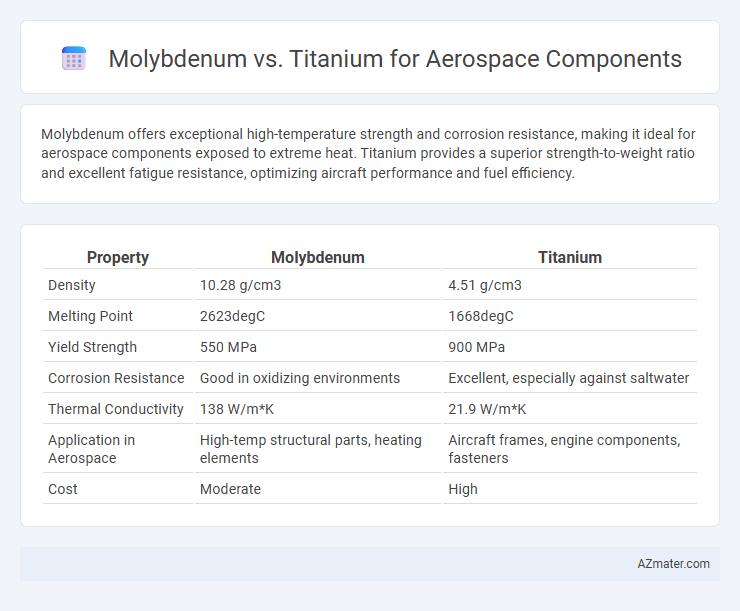Molybdenum offers exceptional high-temperature strength and corrosion resistance, making it ideal for aerospace components exposed to extreme heat. Titanium provides a superior strength-to-weight ratio and excellent fatigue resistance, optimizing aircraft performance and fuel efficiency.
Table of Comparison
| Property | Molybdenum | Titanium |
|---|---|---|
| Density | 10.28 g/cm3 | 4.51 g/cm3 |
| Melting Point | 2623degC | 1668degC |
| Yield Strength | 550 MPa | 900 MPa |
| Corrosion Resistance | Good in oxidizing environments | Excellent, especially against saltwater |
| Thermal Conductivity | 138 W/m*K | 21.9 W/m*K |
| Application in Aerospace | High-temp structural parts, heating elements | Aircraft frames, engine components, fasteners |
| Cost | Moderate | High |
Introduction: Comparing Molybdenum and Titanium in Aerospace
Molybdenum offers exceptional high-temperature strength and corrosion resistance, making it ideal for components exposed to extreme heat in aerospace engines. Titanium is renowned for its high strength-to-weight ratio and excellent fatigue resistance, critical for lightweight structural parts and airframes. Comparing these metals highlights titanium's advantage in weight-sensitive applications and molybdenum's suitability for thermal and wear-intensive aerospace components.
Material Properties Overview
Molybdenum exhibits exceptional high-temperature strength, corrosion resistance, and thermal conductivity, making it ideal for aerospace components exposed to extreme environments. Titanium offers a superior strength-to-weight ratio, excellent corrosion resistance, and biocompatibility, which reduce overall component weight without compromising durability. Comparing fatigue resistance and thermal expansion, titanium provides better performance in cyclic loading conditions, while molybdenum withstands higher service temperatures crucial for engine and exhaust systems.
Strength-to-Weight Ratio Analysis
Molybdenum exhibits exceptional tensile strength but has a higher density of approximately 10.28 g/cm3, resulting in a lower strength-to-weight ratio compared to titanium, which has a density of about 4.51 g/cm3. Titanium alloys, particularly Ti-6Al-4V, provide an optimal balance of high strength (up to 1,000 MPa tensile strength) and low weight, making them preferred materials for aerospace components requiring both structural integrity and weight reduction. Strength-to-weight ratio analysis clearly favors titanium for aerospace applications where minimizing mass without compromising durability is critical.
Corrosion Resistance in Aerospace Environments
Molybdenum exhibits superior corrosion resistance in aerospace environments characterized by high temperatures and oxidative conditions due to its ability to form a stable, protective oxide layer. Titanium also offers excellent corrosion resistance, particularly against saltwater and oxidizing atmospheres, making it ideal for aerospace components exposed to marine or humid conditions. When selecting materials for aerospace applications, molybdenum is preferred for components requiring high-temperature oxidation resistance, while titanium is favored for environments prone to chloride-induced corrosion.
Temperature Resistance and Thermal Stability
Molybdenum exhibits exceptional temperature resistance with a melting point of 2,623degC, making it ideal for aerospace components exposed to extreme heat. Titanium, with a melting point of 1,668degC, offers excellent thermal stability and strength-to-weight ratio but operates effectively at lower temperature thresholds compared to molybdenum. The superior high-temperature performance and thermal conductivity of molybdenum ensure enhanced durability and stability in aerospace environments requiring extreme heat resistance.
Machinability and Fabrication Considerations
Molybdenum offers superior high-temperature strength and excellent wear resistance, but its machinability is challenging due to its hardness and tendency to cause tool wear, leading to increased fabrication costs in aerospace components. Titanium, while having lower thermal conductivity and strength at extreme temperatures compared to molybdenum, provides better machinability and is more adaptable in forming processes such as forging and welding, essential for complex aerospace structures. Selecting between molybdenum and titanium requires evaluating trade-offs between thermal performance and ease of machining, where titanium's fabrication advantages often outweigh molybdenum's superior heat resistance in typical aerospace manufacturing environments.
Cost and Availability of Molybdenum vs Titanium
Molybdenum offers a lower raw material cost compared to titanium, making it an economically attractive option for aerospace components where budget constraints are critical. Titanium, while more expensive, benefits from wider availability and a well-established supply chain that ensures consistent quality and delivery for aerospace manufacturers. The cost advantage of molybdenum can be offset by the extensive processing needed to improve its machinability and corrosion resistance in aerospace applications.
Application Suitability: When to Use Each Material
Molybdenum is ideal for aerospace components requiring high-temperature strength and resistance to thermal expansion, such as jet engine parts and heat shields, due to its exceptional melting point of 2623degC and good corrosion resistance. Titanium excels in structural applications like airframes and fasteners where lightweight strength and fatigue resistance are critical, supported by its high strength-to-weight ratio and corrosion resistance in aerospace environments. Choosing between molybdenum and titanium depends on specific operational conditions, with molybdenum favored for extreme heat tolerance and titanium preferred for weight-sensitive, load-bearing components.
Environmental Impact and Sustainability
Molybdenum and titanium differ significantly in environmental impact and sustainability for aerospace components, as molybdenum mining involves higher energy consumption and toxic byproducts, whereas titanium extraction, particularly via the Kroll process, demands substantial energy but results in lighter, more fuel-efficient aircraft parts that reduce long-term carbon emissions. Titanium's recyclability and corrosion resistance contribute to sustainability by extending component lifespan and minimizing maintenance needs, while molybdenum's durability and resistance to high temperatures offer performance benefits yet pose challenges in eco-friendly disposal. Selection between these metals hinges on balancing immediate environmental costs with lifecycle advantages, emphasizing titanium's growing preference for sustainable aerospace applications.
Conclusion: Selecting the Best Material for Aerospace Components
Molybdenum offers superior high-temperature strength and excellent creep resistance, making it ideal for components exposed to extreme thermal environments in aerospace applications. Titanium provides exceptional strength-to-weight ratio, corrosion resistance, and fatigue performance, crucial for lightweight structural parts. Selecting the best material depends on specific application requirements, with molybdenum favored for heat-intensive components and titanium preferred for weight-sensitive structural elements.

Infographic: Molybdenum vs Titanium for Aerospace Component
 azmater.com
azmater.com